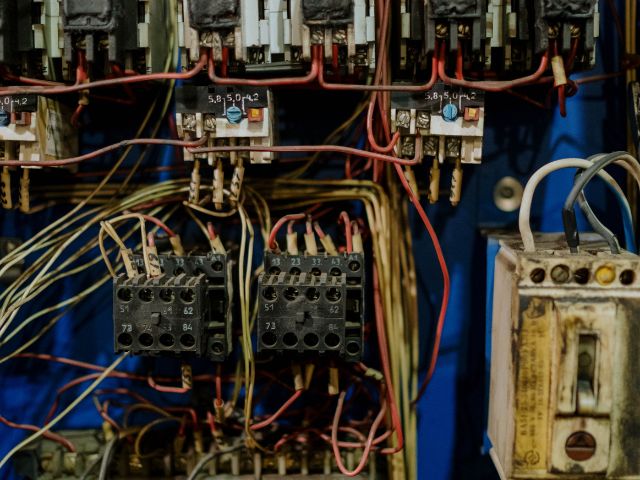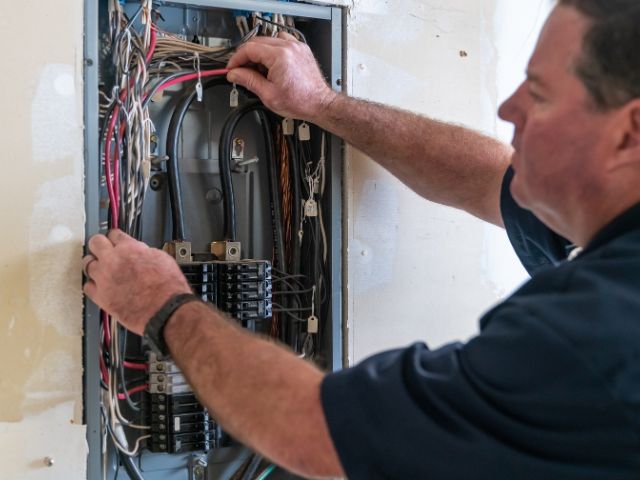Noticed flickering lights when AC turns on? You’re not alone—and yes, it can be a little unnerving. Many homeowners experience this common issue, especially during the summer when the AC works overtime. But what causes it, and more importantly, should I worry about flickering every time my cooling system kicks in? While it might be harmless in some cases, it can also point to deeper electrical concerns. In this blog, we’ll break down why this happens and help you decide when it’s time to call in a professional.
Understanding the Power Demand of an AC Unit
Air conditioners are among the most power-hungry appliances in a household. When an AC starts, especially central or large units, it requires a high inrush current to power up the compressor. This sudden demand causes a momentary voltage drop, which in turn leads to visible flickering of lights.
This flicker often lasts for a second or two and can be more noticeable in older homes with outdated electrical systems. The initial power surge is not abnormal, but if it’s consistent or worsening, it deserves a deeper evaluation.
Common Causes of Light Flickering When the AC Turns On

Power surges cause brief spikes in voltage, which can overwhelm sensitive electronics like computers, routers, TVs, or gaming consoles. If your devices restart on their own or turn off unexpectedly, it’s not just an annoyance—it’s a red flag. Internal components degrade over time with repeated surges, eventually leading to total device failure.
Protective Measure: Invest in high-quality surge protectors or consider a whole-home surge protection system to minimize long-term damage.
1. High Starting Current of the AC Compressor
Air conditioners have compressors that draw a very large current at startup—sometimes 5 to 7 times more than their normal running current. This spike causes a brief voltage dip in the circuit, making nearby lights flicker.
2. Inadequate Electrical Wiring
If the wiring in your home is undersized, outdated, or poorly installed, it might not handle the heavy load. Homes built decades ago weren’t designed to accommodate today’s appliances. Poor wire condition and connections can exacerbate voltage fluctuations, amplifying light flicker.
3. Weak or Faulty Circuit Breaker
Circuit breakers wear down over time. A weakened breaker may not effectively regulate power distribution when the AC activates, causing irregular voltage delivery that results in flickering lights.
4. Shared Circuits
Sometimes, the AC and lighting are on the same electrical circuit, meaning they draw power from the same line. When the AC kicks on, it takes a significant share of the power, leaving less voltage for the lights, leading to dimming or flickering.
5. Faulty Capacitor or Contactor
The capacitor helps your AC start smoothly. If it’s failing, the compressor struggles to start, drawing even more current for longer periods. Similarly, a faulty contactor may cause the AC to start inefficiently, increasing power draw and affecting other electrical components.
When Flickering Becomes a Problem
Not all flickering is problematic, but certain symptoms indicate it’s time to take action:
- Lights flicker more than momentarily
- Flickering is accompanied by buzzing sounds
- Lights dim significantly and don’t return to full brightness immediately
- Multiple lights or appliances are affected across different rooms
- Circuit breakers frequently trip
These issues could be warning signs of overloaded circuits, failing equipment, or more serious electrical risks, such as potential fire hazards. If you’re noticing these signs, it may be time to consult professionals who specialize in emergency electrical services to diagnose and address the problem quickly and safely.
Dangers of Ignoring Flickering Lights
Overlooking flickering lights when your AC turns on can lead to:
- Premature appliance wear and tear
- Decreased energy efficiency
- Fire hazards due to overheating wires or faulty circuits
- Damage to sensitive electronics
- Potential code violations and home insurance issues
Addressing the cause promptly ensures the safety and longevity of both your AC and your home’s electrical system.
How to Stop Lights from Flickering When AC Turns On
1. Install a Hard Start Kit
A hard start kit helps your AC compressor start more efficiently with less inrush current, reducing the burden on your circuit and minimizing voltage drop.
2. Upgrade the Electrical Panel
Older electrical panels might not meet modern amp requirements. Upgrading to a 200-amp service from a 100-amp panel can provide your home with the capacity it needs to operate high-demand appliances without flickering lights.
3. Use Dedicated Circuits
Ensure that your AC unit is on a dedicated circuit separate from your lights and outlets. This prevents power-sharing and stabilizes voltage delivery during AC startup.
4. Check and Replace Wiring
Have a licensed electrician inspect your wiring for signs of corrosion, undersizing, or damage. Replacing old aluminum or worn-out copper wiring with modern materials can greatly enhance circuit stability.
5. Replace the Capacitor
If your AC unit has trouble starting, a bad capacitor could be the cause. Replacing it not only solves flickering issues but can also extend the life of your AC.
Should You Call an Electrician?

Yes—especially if:
- Flickering is frequent and severe
- You notice burning smells or warm outlets
- Your AC struggles to start or frequently trips the breaker
- You live in a home built before 1990 with no major electrical upgrades
These signs can point to underlying issues that demand immediate attention. A licensed electrician can perform a load calculation, evaluate your service panel, inspect for loose connections, and offer reliable, code-compliant solutions. For peace of mind and lasting results, professional residential electrical services are your best bet.
Preventative Tips to Avoid Future Flickering
- Schedule annual HVAC maintenance service
- Upgrade to energy-efficient appliances
- Use LED lighting, which is less sensitive to voltage fluctuations
- Don’t overload circuits with too many devices
- Regularly inspect your electrical panel for signs of aging or damage
Proactive care can prevent issues from developing and reduce the strain on your home’s electrical system.
Conclusion
If flickering lights are a constant annoyance every time your AC turns on, don’t brush it off—it could be a sign of deeper electrical issues that shouldn’t be ignored. While some flickering is harmless, persistent or severe dimming may indicate outdated wiring, overloaded circuits, or failing components. These concerns not only affect comfort and appliance performance but can also pose a serious fire risk flickering lights situation.
To protect your home and peace of mind, it’s best to consult professionals. A licensed electrician from Electricians Services Team can pinpoint the issue and ensure your home’s system is safe, efficient, and up to code. Stop searching endlessly for electrical service near me—reach out to the team you can trust for fast, reliable help today.
FAQs
Yes, a brief flicker is common due to the high inrush current during AC startup. However, frequent or severe flickering may indicate an underlying electrical issue.
Yes, consistent voltage drops can stress sensitive electronics and reduce their lifespan. It’s best to address the root cause to protect your devices.
If your panel is outdated or undersized, an upgrade can prevent flickering and accommodate modern electrical loads. A licensed electrician can determine if this is necessary.
A hard start kit can reduce the AC’s startup demand and minimize voltage dips. It’s an effective solution for compressors that cause light flickering.
Minor issues like loose bulbs can be DIY, but electrical or HVAC-related flickering should be handled by professionals. Safety and code compliance are top priorities.





